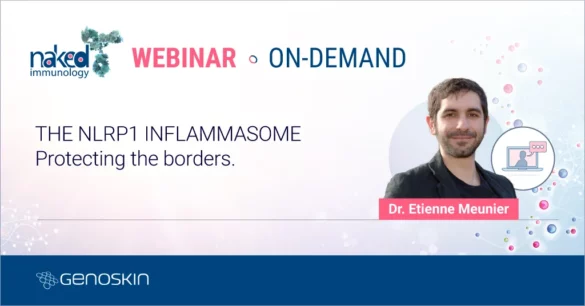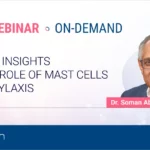Top-level science through the eyes of an expert.
Mast cells and anaphylaxis: emerging mechanisms & pathways
Did you miss the live session? You can now watch the full webinar replay on demand where Dr. Soman Abraham explores groundbreaking discoveries in mast cell biology and their role in anaphylaxis. This session uncovers how mast cells interact with dendritic cells, nerves, and inflammasome pathways to drive life-threatening allergic reactions—and why food-induced anaphylaxis can be especially severe.

Evolving insights into the role of mast cells in anaphylaxis
Mast cells have been recognized as the primary effector cells in anaphylaxis for over half a century, yet key questions remain. How do mast cells detect allergens and trigger a rapid, systemic response? And why are food-induced allergic reactions often especially severe?
In this talk, Dr. Abraham will present findings from his team’s recent studies using mouse models of IgE-mediated anaphylaxis. The team discovered that mast cells can rapidly detect blood-borne allergens with the help of perivascular dendritic cells. These dendritic cells extend dendrites into blood vessels to sample circulating allergens and then transfer them to neighboring mast cells via extracellular vesicles.
When mast cells throughout the body are simultaneously activated by allergens, they undergo widespread degranulation, releasing granules that interact with peripheral nerves. This interaction causes the nerves to send false heat signals to the central nervous system (CNS), which responds by inducing hypothermic shock—a hallmark of severe anaphylaxis. These findings reveal a previously unrecognized neuroimmune pathway in which mast cells engage the CNS to amplify the anaphylactic response.
The team also identified a critical role for inflammasome components NLRP3 and ASC in mast cell degranulation. In their absence, mast cells fail to degranulate. Following IgE-mediated activation, these components localize to granule membranes and facilitate granule mobilization to the cell surface, enabling extracellular release.
Interestingly, the team found that mast cells previously exposed to endotoxins, such as those in the gut, co-release large amounts of IL-1β upon degranulation. This leads to a more severe, often lethal, anaphylactic response in mice. These findings may help explain why food-induced anaphylaxis is particularly dangerous and suggest new therapeutic targets for intervention.
Together, these studies reveal how mast cell activation by allergens can result in rapid systemic and neural responses, offering new insights into the pathogenesis of anaphylaxis and potential avenues for therapeutic development.
Watch the Replay
After submitting this form, you will receive an email containing the link to access the replay.
About the speaker:

Dr. Soman Abraham
Grace Kerby Distinguished Professor, Departments of Pathology, Molecular Genetics & Microbiology, and Immunology, Duke UniversityProfessor, Program in Emerging Infectious Diseases, Duke-NUS Graduate Medical School, Singapore
Education and Training:
B.Sc., Ahmadu Bello University, Zaria, Nigeria
Ph.D., Newcastle University, Newcastle upon Tyne, United Kingdom
Research Interests and Accomplishments:
Dr. Abraham has devoted over four decades to advancing the fields of allergy, microbial pathogenesis, and immunology. His research investigates the molecular mechanisms underlying interactions between allergens, microbes, and immune cells, with the goal of identifying novel strategies to prevent and treat infectious and allergic diseases.
He has made pioneering discoveries on the role of mast cells in regulating both innate and adaptive immune responses to microbial infections and in driving the pathogenesis of anaphylaxis. These findings have significantly advanced our understanding of immune cell function in host defense and allergic inflammation.
Dr. Abraham is a recipient of the NIH MERIT Award and has been elected Fellow of both the American Society for Microbiology and the American Association for the Advancement of Science. He has authored more than 200 peer-reviewed publications and holds several international patents. A dedicated mentor, he has trained numerous scientists who now hold prominent positions in academia and industry worldwide.
Additional resources on Dr. Abraham’s research
A mast cell-thermoregulatory neuron circuit axis regulates hypothermia in anaphylaxis.
Bao C, Chen O, Sheng H, Zhang J, Luo Y, Hayes BW, Liang H, Liedtke W, Ji RR, Abraham SN. Sci Immunol. 2023 Mar 17;8(81):eadc9417. doi: 10.1126/sciimmunol.adc9417. Epub 2023 Mar 17. PMID: 36930731; PMCID: PMC10331449.
Anaphylactic degranulation by mast cells requires the mobilization of inflammasome components.
Mencarelli A, Bist P, Choi HW, Khameneh HJ, Mortellaro A, Abraham SN. Nat Immunol. 2024 Apr;25(4):693-702. doi: 10.1038/s41590-024-01788-y. Epub 2024 Mar 14. PMID: 38486019.
Mast cell-sensory neuron crosstalk in allergic diseases.
Bao C, Abraham SN. J Allergy Clin Immunol. 2024 Apr;153(4):939-953. doi: 10.1016/j.jaci.2024.02.005. Epub 2024 Feb 17. PMID: 38373476; PMCID: PMC10999357.
Perivascular dendritic cells elicit anaphylaxis by relaying allergens to mast cells via microvesicles.
Choi HW, Suwanpradid J, Kim IH, Staats HF, Haniffa M, MacLeod AS, Abraham SN. Science. 2018 Nov 9;362(6415):eaao0666. doi: 10.1126/science.aao0666. PMID: 30409859; PMCID: PMC6376486.
Catch up on previous webinars
Comments are closed.













